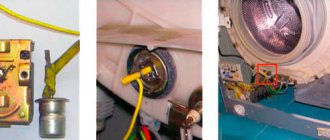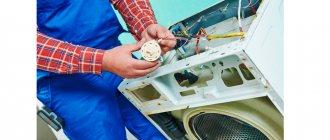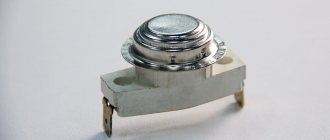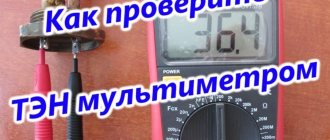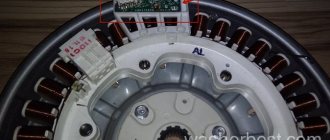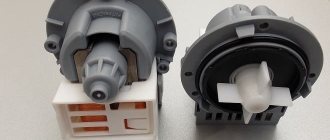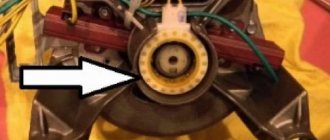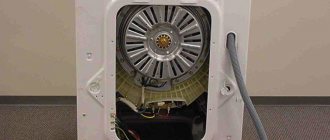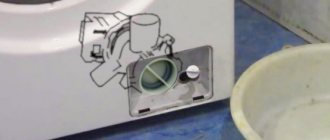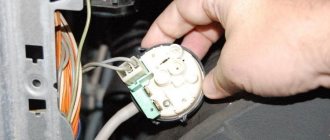Thermostat failure is a common problem with washing machines. It is not difficult to replace a washing machine thermostat with your own hands, but first, briefly about the purpose and operation of these devices.
Thermostats (on modern models of washing machines - thermistors) are used to control the heating temperature of the water during various washing modes. Sometimes all these devices are called temperature sensors. The thermostat is a metal or plastic disk, similar to a tablet, with a diameter of 2.5–3 cm, which is usually installed in the lower part of the machine body at the rear. The sensor part of the thermostat is located inside the tank and comes into contact with water.
Types of thermostats
There are 3 types of thermostats:
- Gas-filled. They consist of a sensor, a can with a tube filled with freon, and a control device. As the water temperature rises, the gas expands and presses on the plate, which opens the contacts and disconnects the heating element from the network.
- Bimetallic. Such thermostats are located inside a drum in heated water. The operating principle is based on closing (opening) the contact when heating (cooling) the bimetallic plate.
- Thermistors. New models of machines use thermistors that send a signal to the control board that turns off the heating element. The operation of such sensors is based on changes in the resistivity of the material when heated. Structurally, such a device is much more reliable, because has no mechanical circuit.
How to ring a heating element with a multimeter
If the readings of the temperature sensor turned out to be correct when checking it, and the washing machine still washes in cold water, then the heating element needs to be checked with a multimeter. It is quite simple to check the heating element with a tester; to do this, you need to remove the wires from it, set the multimeter to measure the minimum resistance and ring the heater contacts with probes.
The resistance of the water heater should be 25-35 Ohms. Afterwards, you need to check for a possible breakdown in the housing. To do this, set the multimeter to the maximum resistance measurement values, touch any of the contacts of the part with one probe, and its body with the other.
With an intact case, the resistance on the tester will be equal to unity. To check the heating element for breakdown of the housing, it is necessary to first keep it in water for some time; a dry heater can show positive measurement results.
A faulty heater must be replaced to ensure proper operation of the washing machine and to avoid electrical shock to users of the appliance. Most modern washing machines recognize a breakdown that occurs on the body of the washer and turn off the program.
Also, if there is an RCD in the power supply circuit of the washing machine, then this device completely de-energizes the outlet at the slightest breakdown of electricity on the product body. This can also occur due to the use of electrical appliances in poorly ventilated areas or in high humidity.
Signs and causes of malfunction
The following signs indicate a thermostat malfunction:
- the water is heated to a boil, regardless of the set temperature limit mode;
- strong heating of the machine body during washing, hot steam from under the lid;
- the water does not heat up at all, although the electronic control records the temperature.
The cause of failure of the bimetallic thermostat is physical wear and destruction of the plate. In this case, the plate does not bend and the water heating does not turn off.
The gas-filled thermostat does not work due to a leak in the tube and evaporation of freon from the system. You can repair the thermostat by replacing the tube or restoring the tightness, as well as filling the system with freon.
Thermistors rarely fail. The cause may be a manufacturing defect.
Variety of temperature sensors
An automatic washing design can be equipped with only one of the following three temperature sensors :
- Bimetallic;
- Thermistor;
- Gas-filled.
The bimetallic temperature sensor looks like a tablet, approximately 20-30 millimeters in diameter and 10 millimeters in height. Inside this small tablet is a bimetallic strip. During the process of heating water, when it reaches a certain temperature, the plate bends and creates a closure of the contacts. Under this condition, the heating process is completed.
Diagnostics and replacement of temperature sensors
Washing machine thermostat replacement tool:
- Phillips screwdriver;
- flat screwdriver;
- 10 mm socket wrench;
- tester;
- waterproof glue or silicone.
To replace the thermostat in your washing machine, you need to find out where the thermostat is installed. On most models it is located under the back cover along with the heating element (at the bottom of the drum). But, for example, on Bosh and Siemens machines the thermostat is located behind the front panel, and to dismantle it you need to remove the top and front panels. The installation location of the temperature sensor on your machine can be clarified in documents or on the Internet.
Replacing a gas-filled thermostat
Sequence of operations:
- disconnect the machine from the network;
- drain the water from the tank;
- unscrew the screws and remove the cover;
- loosen the heating element fastening with a key;
- take a photo of the connection diagram before removing the power wires from the thermostat;
- carefully remove the thermostat with a flat screwdriver, being careful not to damage the rubber seal;
- remove the temperature regulator from the control panel;
- inspect the installation site and, if necessary, treat with sealant or glue;
- Install the new thermostat in reverse order;
- turn on the machine and check the operation of the thermostat in heating mode up to 40 degrees.
Replacing a bimetallic thermostat
Subsequence:
- disconnect the machine from the network;
- drain the water from the tank;
- remove the cover;
- loosen the heating element fastening with a key;
- take a photo of the connection diagram before removing the power wires from the thermostat;
- remove the thermostat;
- measure resistance with a tester at room temperature;
- Place the thermostat in hot water and measure the resistance again. If the measurement result does not change or changes slightly, the sensor should be replaced;
- installing the thermostat is done in the reverse order;
- turn on the machine and check the operation of the thermostat in heating mode up to 40 degrees.
Replacing the thermistor
Subsequence:
- disconnect the machine from the network;
- drain the water from the tank;
- remove the cover;
- loosen the heating element fastening with a key;
- take a photo of the connection diagram before removing the power wires from the thermistor;
- remove the thermistor, measure the resistance with a tester and compare with the nominal value for a given machine model;
- install and connect the new thermistor in the reverse order;
- turn on the machine, check the operation of the thermistor in heating mode up to 40 degrees.
Attention! All work should be carried out only after disconnecting the machine from the network!
How to check the temperature sensor of a washing machine
If the washing machine begins to behave differently than usual, namely:
- Takes a long time to wash;
- To the touch when washing, the sunroof glass remains cold or very hot (not according to the set temperature);
- The program crashes and an error code appears on the display;
- After washing, poor quality of dirt removal was revealed; then you need to check the thermostat for proper operation;
- To do this you need to determine where it is. It is best to dismantle it from the installation site and check it outside the machine.
This is done differently in different models of washing machines, but the principle is the same in all cases.:
- LG machine . Remove the back cover of the product. The temperature sensor in the lg washing machine is located either in the heater itself or in the tank to the left of the heating element. To dismantle it, you need to loosen the spiral mounting nut, remove the wires from the thermostat and pull it towards you. Set the multimeter to measure resistance on a 200 kOhm scale. Take measurements at room temperature. Touch the sensor contacts with the probes. The resistance of the go should be approximately 50 kOhm.
- After this, I do not remove the probes from the contacts and lower the sensor into preheated water. The sensor resistance should change smoothly without interruptions in the readings on the tester screen (the readings should not disappear). If the readings disappear or are absent at all, then the sensor must be replaced with a new one;
- Washing machine Indesit . Remove the back cover of the machine. The sensor is located in the heater. Loosen the heating element and remove the sensor from it, having first disconnected the wiring from it.
- The readings of a working sensor at room temperature are approximately 20 kOhm. When it is heated in hot water, the readings will decrease;
- Bosch washing machine.
In order to get to the thermostat you need:
- Remove the powder tray and unscrew the screw in its niche;
- Then open the inspection window of the pump filter, unscrew the self-tapping screw securing the false panel;
- Move the false panel to the right and then towards you;
- Underneath it, unscrew 2-4 screws securing the front removable part of the case;
- Open the hatch and dismantle the outer clamp of the cuff, tuck the rubber itself into the body;
- Lift the lower part of the front panel away from the body a couple of centimeters and pull it down, it will come off the guides. All that remains is to disconnect the wires from the lock;
- The heating element of the machine with the sensor inside will be visible at the lower front of the tank;
- Loosen the heater mount and remove the thermistor. Its normal resistance will be 6.2 VOhm. If the readings differ significantly from the nominal value, then it is necessary to replace the temperature sensor in the washing machine;
- Washing machine Kandy. The temperature sensor in products of this brand has the shape of a tablet and is located in the back of the tank outside the heater. Its normal resistance is 20 kOhm; when heated, the readings should decrease;
- Samsung products. In these washing machines, the sensor we are describing is located at the front of the machine, installed in the heating element.
Call the master
It is not always possible to determine the cause of the failure and repair a Bosch washing machine on your own. If you have doubts that you can do everything yourself, it is better to contact a household appliance repair company .
Such companies are present in every city. Information about them can be found on the Internet, where you can read reviews, study the price list and list of services.
The cost of work may vary between individual companies. The average prices for Bosch repairs in the capital of the Russian Federation are as follows:
- replacement of heating elements - from 1,700 rubles;
- repair of the control module – from 2500 rubles;
- wiring repair – from 1500 rubles.
The price of new parts for a Bosch washing machine is paid by the customer and is not included in the cost of work.
Removing an element with a bimetallic plate
The location of the bimetallic sensor is no different from the usual one - it is “hidden” under the tank of the washing machine. To gain access to the part, it is necessary to partially disassemble the machine body. Having reached the element, you need to disconnect the wiring, remove the thermistor and check its resistance with a multimeter.
After measuring the value at room temperature, warm up the sensor and repeat the test again. The indicator on the device screen should decrease significantly. If there is no sharp fluctuation in resistance, you will have to replace the element. Most often, bimetallic temperature sensors stop working due to plate wear. The element cannot be repaired. It is necessary to find, buy and install a new part similar to the one removed.
Source
Possible difficulties
If there is no water heating, and searching for a solution to the problem, you may encounter certain difficulties:
| Problem | Ways to solve the problem |
| The washing machine is under warranty | You should not open the washing machine body yourself. If a failure is detected, you need to contact the service center |
| The new heating element does not fit into the seat | Most likely, a heating element that was not suitable for this washing machine model was selected. |
| Can't get the heating element | The part is held in place by a central nut. In addition, the heating element itself “sits” quite tightly, which allows you to avoid leaks |
| After replacing the heating element, the water in the drum still does not heat up | It is necessary to check the other components that are involved in the water heating process. There is a possibility that it was not only the heating element that was worn out |
